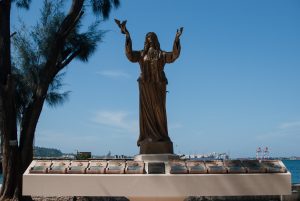Yesterday marked 29 years since the Senate vote that brought the curtain down on the giant U.S. naval base at Subic Bay. For much of the twentieth century, the U.S. Naval Station Subic Bay, and its companion U.S. Air Force base at Clark, some 50 kilometers to the north, had been a critical node of America’s military operations in the Pacific. Blessed with abundant deep water anchorages, and commanding close access onto the strategic South China Sea, it had played a part in every major U.S. military deployment of the century, from the Boxer Rebellion to Operation Desert Storm.
But the approaching end of the Cold War, concerns about the behavior of U.S. troops, and the eruption in June 1991 of Mount Pinatubo, which severely damaged the facilities at both bases, spelled the end for the huge naval facility.
On September 16, 1991, the Philippines Senate rejected a proposed extension of the basing agreement by a 12-11 vote. The extension had prompted an impassioned debate in which the bases were attacked as a symbol of the country’s continued colonial-like dependency on the U.S., which had ruled the Philippines as a colony prior to its independence in 1946. After considering putting the bases agreement up to a popular referendum, President Corazon Aquino gave the U.S. until the end of 1992 to vacate the site.
On November 24, 1992, the Stars and Stripes were lowered in a solemn ceremony at Subic Bay, and the Philippine national flag hoisted in their place. The base’s closure ended an American military presence that began with the capture of the Philippines from Spain in 1898.
Today, the fateful Senate vote is marked by a monument located in front of the boxy building that once housed the U.S. base headquarters. The monument features the hand prints of the twelve senators, topped by a Virgin Mary-like figure releasing a bird into the sky. An inscription reads, “Let the Dozen Hands pay tribute to the Magnificent Twelve Senators of the Republic of the Philippines, who on September 16, 1991, stood up and declared ‘NO’ to the RP US Military Bases Treaty, thus finally ending more than four centuries of foreign military presence in the country.”
But the U.S. military absence from the Philippines was to be short lived. In February 1992, the Chinese government promulgated a law asserting its claims over a vast swathe of the South China Sea. Two years later, it occupied Mischief Reef, in the eastern part of the disputed Spratly Islands close to the Philippine island of Palawan, in the face of opposition from Manila, and began erecting structures on the coral banks. Facing this rising power to its west, the Philippines turned once again to its treaty ally and former colonial master for support.
In 1998, less than six years after the closure of Subic, the Philippines and the U.S. signed a Visiting Forces Agreement, laying out the rules for American personnel deployed in the Philippines. The VFA also led to the establishment of the Balikatan military exercises, which have since been held more than 35 times. In 2014, in the wake of a new round of aggressive Chinese action in the South China Sea, during which it began building Mischief Reef and other Spratly Island features into fortified artificial islands, the VFA was supplemented by an Enhanced Defense Cooperation Agreement, which permitted the U.S. to rotate conventional forces through Philippine military bases. At around the same time, navy ships started berthing again at Subic Bay.
The campaign for the removal of the U.S. bases, and the subsequent return of the American military to the Philippines, encapsulates the nation’s complicated relationship with its former colonial master. As the most visible sign of America’s residual presence in the Philippine archipelago, the U.S. military presence continues to be a focus for the periodic eruptions of resentment against American influence. This burst forth last week, in the protests that greeted President Rodrigo Duterte’s decision to pardon an American Marine convicted for the 2015 killing of a transgender woman at a hotel in the town of Olongapo, which sits adjacent to the former Subic Bay base. At other times, Duterte has himself been harshly critical of past American actions in the Philippine islands.
At the same time, many Subic Bay locals still lament the closure of the U.S. naval base, which once provided employment for tens of thousands and supported a thriving local economy. In 2019, when I visited Subic, since converted into a somnolent free trade zone, many of those I met spoke of an economy that had never quite recovered from the U.S. withdrawal, of empty shopping malls and sparsely-filled restaurants.
In a park a short walk from the monument to the 1991 Senate vote, I ran into 55-year-old Lito Romero, a rake-thin taxi driver who once worked at the Subic Bay ammunition pier. The park was built over a mini-golf course once built for the use of American personnel, but since abandoned. Roots twined across the concrete putting ranges, once-bright paint flaking in the dappled shade.
Romero wore a baseball cap bearing the insignia of the USS Charlotte, a Los Angeles-class submarine that had paid a visit to Subic in 2016. I asked him what the impact of the closure had been. “Bad, it was very bad,” he said, lounging on a bench, “People had no work.”
Sitting with him was Christy Jimenez, 60, a volunteer who manned the public bathrooms in the park. Having grown up in Olongapo, and seen the local economy rise and fall, she spoke with scorn of the senators who voted to shut down the base. “What did they do, the senators? They took all the work, right. That’s no good,” she said, before adding: “I cannot vote for those people, how can you vote for those people?”

































